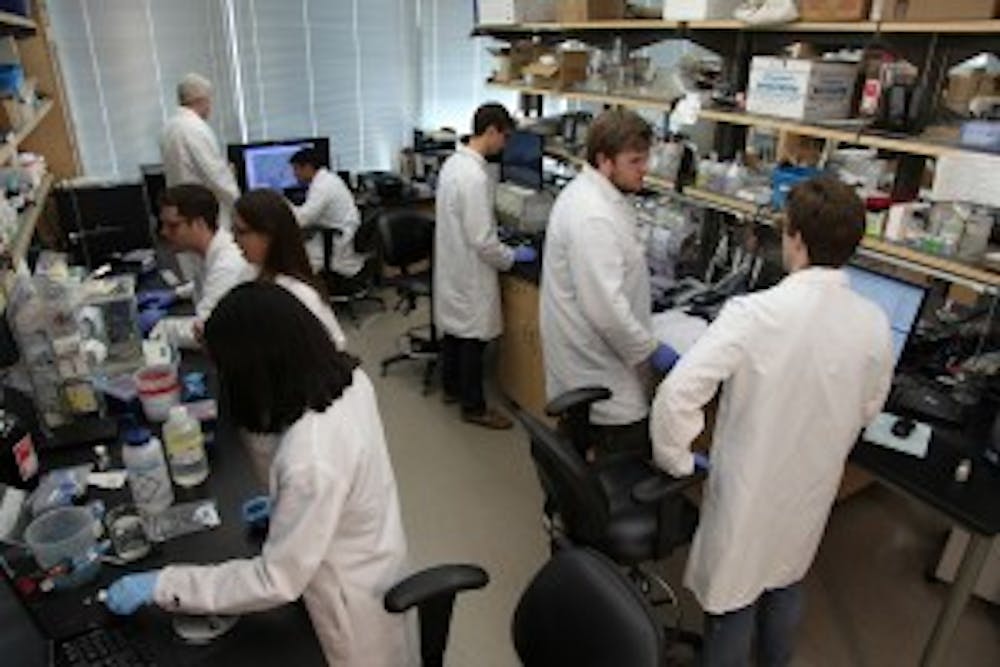 Researchers in Professor Jeffery La Belle’s lab have been working hard to develop a better alternative to blood-based glucose monitors. (Photo Courtesy of Jeffery La Belle)
Researchers in Professor Jeffery La Belle’s lab have been working hard to develop a better alternative to blood-based glucose monitors. (Photo Courtesy of Jeffery La Belle)A team of researchers at ASU received a $65,000 grant from the Mayo Clinic earlier in September in order to continue their work on a tear-based glucose meter that could forever change the lives of diabetics.
Diabetes patients have long been subject to a painful routine of finger pricking in order to monitor their blood sugar content, but a new type of glucose meter that measures sugar content in tears could render blood-based meters obsolete within the decade, researchers said.
Assistant Professor Jeffery LaBelle, an ASU alumnus who teaches at the School of Biological and Health Systems Engineering and is involved in the meter’s development, said the history of diabetes research has been a long and interesting one, and glucose-measuring technology has developed significantly over the years.
The study of glucose levels in diabetics started out in urine in the 1800s, he said.
“You can taste urine from a diabetic and realize it’s very sugary,” La Belle said, laughing. “It was a horrible way to discover this, and I don’t know how it happened.”
LaBelle emphasized he’d never tried tasting diabetic urine himself, but he said this observation laid the foundation for all future research.
In the early 1900s, scientists built off of the urine research by studying the sugar content of both tears and blood in diabetics, but they maintained a focus on blood-based measurement because aggressively stimulating tears created a stress response that often resulted in false readings.
The modern tear-based glucose meter being developed at ASU would be gentle enough to avoid the harmful stress response, he said.
Using the new meter involves only a quick, gentle touch to the eye in order to take a tear sample and read its glucose level.
LaBelle is the a head researcher on the project and supervises students in his lab as they conduct research for and design the new tear-based glucose meter.
He said the part of his job he likes most is working with students as they try to solve a variety of problems, such as making the device more compact and user-friendly.
“I really love working with the students,” he said. “I’ve got over 60 students in my lab, and I just really like the whole process involved in talking and working with them.”
ASU doctoral student Chi Lin, who studies biomedical engineering, is a research assistant in LaBelle’s lab and said he enjoys being there.
He said the lab is a fun and interesting place to work, but he said working on the glucose meter isn’t without its challenges.
“The first (problem that we face) is when things are going down to the micro level,” Lin said. “We’re trying to be with only 0.5 micrometers of area for the toucher … and that’s really small.”
Lin said using a sponge this small is very different from using a sponge the size of one most people might find on their kitchen sink, and it is difficult to facilitate sufficient absorption of moisture in the eye.
He said one of his most challenging questions has become how to maximize the efficacy of the tiny sponge.
“How do we figure out how we can capture a consistent amount of fluid very easily so that the patient doesn’t have to scratch their eye in order to collect a full tear?” he said.
Lin said another challenging aspect of the project is making the device easy to manufacture, as it will eventually be mass-produced and sold for everyday use.
Dr. Curtiss Cook, a professor of medicine who specializes in endocrinology at the Mayo Clinic in Scottsdale, has worked with LaBelle’s lab on the glucose meter by providing an extensive knowledge of diabetes.
Cook said his favorite part of the project is the possibility that their collaboration could mean a more painless lifestyle for diabetes patients.
“I most enjoy the collaboration and the prospect of bringing something new to help the patient with diabetes manage their disease in a painless way,” he said in an email.
Reach the reporter at megann.phillips@asu.edu or follow her on Twitter @megannphillips
Like The State Press on Facebook and follow @statepress on Twitter.




